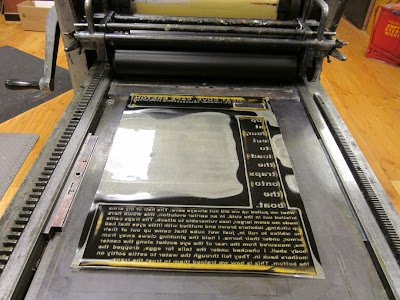
A while ago I wrote a post describing the severe physical consequences of not storing one’s photopolymer plates properly. I never really tried to print those curled plates—I attempted to attach one to the base to see if it would flatten out, and it didn’t, so those never got used. But I did, at another time, for another project, manage to print from some plates that were severely warped.
The pictures shown in this post are from January of 2011. [I had forgotten about them until recently.] Before I left the Bay Area in August of 2010, I had made the plates necessary to print the letterpress portion of KC Trommer’s and Brenda Iijima’s broadsides. Those plates were stuck in an envelope and shipped to Colorado, and then they sat at the Press until I made time to print them in January. Which means they had been sitting, with minimal protection from the environment, for roughly 5 months. I think that the envelope that they were in did keep most light off of them, and provided restraint against severe curling, but they were far from perfect. Fortunately, for these projects, less-than-perfect plates were okay. (All of the printed “negative” space on these would eventually be peeled away, so print quality did not matter.) And their less-than-perfectness provided some interesting results.


Two things made these plates particularly prone to warping—the large amount of solid areas of type-high polymer, and the very dry climate here in Colorado. One thing that I was surprised about is that the plates don’t just curl, but that the actual surface can change shape over time.


A not-flat printing surface means that solids are not solid. In some cases, the shapes of the letters were just barely visible enough to do the cutting.




A little bit into the runs the plates actually cracked. (The curling is a result of the plates slowly hardening and drying out, meaning that they are also becoming more brittle.)

That reminded me of Robert Rauschenberg’s lithograph from 1963, Accident, where the stone broke during printing, but was used anyway and incorporated into the print.

When I went back to printing What You Will about a month ago, I was concerned because even though I had stored the plates properly (flat, in plastic bags and in the dark) they had still curled quite a bit. And I had imagined them being as printed as dark, flat, perfectly geometric solids. I didn’t know what would happen. I was worried that the surface of the plates had warped and the type would be completely illegible. And I wondered, not so much worried, if the plates would crack. And I think that if they had, and assuming that the cracking would not have rendered the small type completely illegible, I would have went with it. Partly because I couldn’t afford to remake those plates for a third time, and also because the cracks would have added another layer of legibility. A nice, dark, as-planned solid lends a physicality to the print (especially in a book where the ink can be touched by the reader) but I think that they remain (at least somewhat) abstract. Whereas a cracked plate + print would be more concrete, more specific, more opaque, more legible, more present. The reader would be brought ever so slightly closer to the matrix and to the process.
So maybe, maybe next time I will figure out how to really destroy those plates.






No comments:
Post a Comment